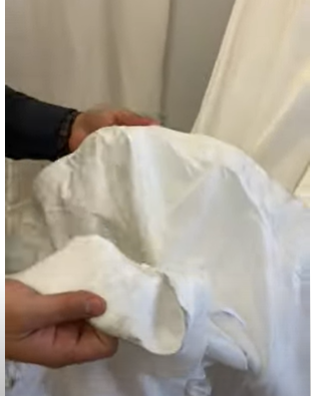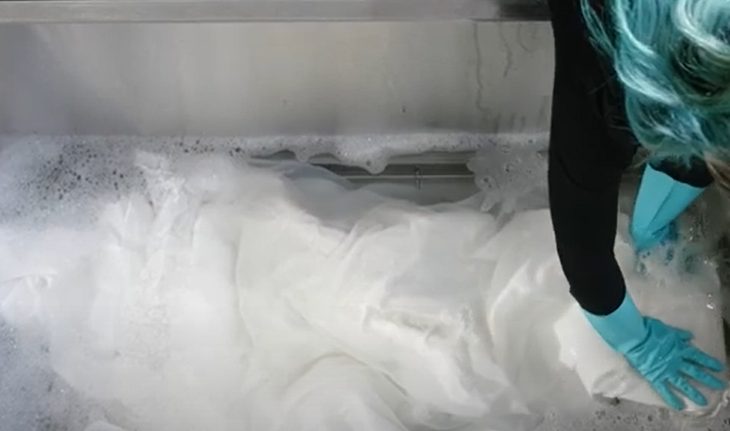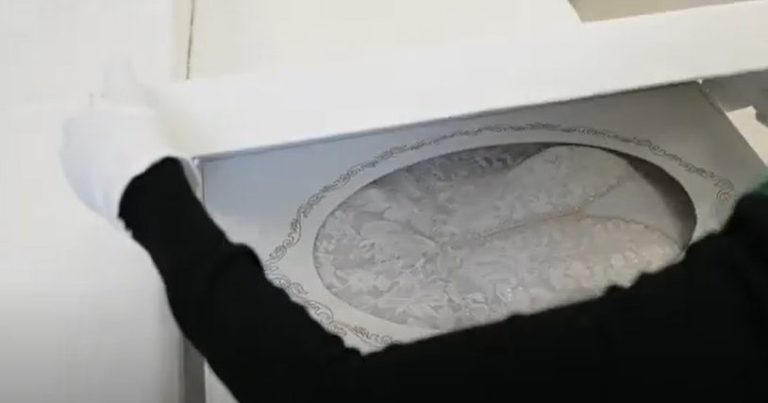Now your big day has passed, and you find yourself staring at your closet, adorned in your most pricey apparel—your wedding gown. What shall you do next? Maybe you are a newlywed and have heard of wedding dress preservation. We are here to guide you about wedding dress cleaning, steaming, and preservation.
Wedding Dress Cleaning
In This Article
When trying to figure out how to clean your wedding dress, keep in mind that, compared to other garments, wedding dresses can be a bit of a distress, particularly if they include intricate details like lace, tulle, or beading. Furthermore, you can achieve a ripped or fully-enacted look depending on how you wash your outfit. The most convenient option is to have your gown professionally washed, but if your gown’s care instructions permit it, you can certainly clean it personally.
How Do You Preserve Your Wedding Gown?
Carefully washing and keeping your gown so that it keeps its shine is called preservation. Your dress will be dirty after being dragged down the aisle and onto the dance floor all day. The good news: it can look brand new with some love and care. A trained preservationist will examine your gown’s construction, details, and stains before developing a unique cleaning plan. “Cleaning your gown is the single most important part of the preservation process and all the stains, including the hidden ones containing sugar that turn brown over time, must be removed,” Conant adds. Your cleaned gown will be carefully stored in an archival box of museum grade after being covered in acid-free tissue paper.
1) Check the Material and Directions:

Loved Twice Bridal owner Sarah Ghabbour says, “The cleaning process, solvent options, and thoroughness of a gown’s cleaning are all affected by its composition. Gowns crafted completely of polyester, as an example, tend to last far longer than their silk competitors.” To find out if there are any particular cleaning recommendations, you can either contact the manufacturer or check their website. Looking for the best way to clean a certain fabric could sometimes yield useful results as well.
2) Eliminate the Stains:
It is important to check your dress thoroughly for stains after the big day, even if you feel confident in its cleanliness. “Stains are unavoidable because most wedding dresses are very long and contact the floor numerous times during the ceremony.,” explains Wright.
Spot cleaning with a stain remover is her recommendation; she also mentions that white vinegar and baking soda are effective alternatives. “As you’re applying the stain remover, you can ensure it isn’t soaking into other layers of the dress by placing a paper towel underneath the stain,” says Wright. “This will keep the stain from transferring to another layer of the dress as well.”
3) Get the Cleaning Done:


Since this is going to be the dirtiest and most difficult part of your garment, Wright says to clean the train and hemline first. The stylist suggests filling the tub with warm water and a mild detergent to achieve this look. After filling, immerse the train and hem and let them sit for a few hours. After soaking the dress in the tub, use a toothbrush and detergent to gently scrape the hem, if you feel the need for a more intensive cleaning.
Afterward, start at the bottom of the gown and scrub it thoroughly. The bodice, on the other hand, is easier to clean. Wright recommends inverting your gown before spraying it with a mixture of warm water and a mild detergent to clean the bodice. “Once the garment is turned inside out, gently scrub it with an unused toothbrush to clean it,” according to her.
4) Wash and Set Aside:
Wright suggests filling the tub with warm water to rinse the detergent off the gown after you believe it is clean enough. “You can remove the soap from the garment by gently swishing it around, but you might need to do it a few times before it’s completely gone,” according to her. The garment will be too heavy to hang, so when you’ve rinsed it thoroughly, you can dry it by draping it over the curtain rod. After the garment has dried entirely, gently press it with a steamer and put it away.
The Best Way to Steam Your Wedding Gown:
Chapman recommends an up-and-down motion while holding the steamer two to three inches away from the fabric if you’re a beginner who’s nervous about steaming. “Watch for the fine lines and wrinkles to fade—it’s a rewarding sensation!” Being patient or giving the job to someone else is the most crucial thing you can do during this period. If the dress is particularly huge or has a lengthy train, the operation can take as long as three hours.
Steaming some garments from the inside may yield better results for more experienced steamers. For silk shantung and chiffon bridesmaid dresses, Chapman recommends pulling the garment taut while running the steamer vertically across the garment to smooth out any wrinkles.
Steaming Errors to Prevent:
Relax if a water ring is left behind by your steamer. Let it dry. Would you like it gone immediately? “You should use a washcloth to dab it, make sure it’s completely dry, and then apply steam to the area,” advises Chapman. “The extra steam will help evaporate any moisture in the fabric, making the likelihood of a ring less likely.” Another option for swiftly drying the area is to use a hairdryer set to its lowest warm setting.
Especially with a voluminous and delicate skirt, steaming just the top layer of a multi-layered skirt will not provide the desired effect. To get the desired drape from the skirt, steam each layer separately, starting from the inside and working your way out.
Conclusion: Wedding Dress Cleaning, Steaming, and Preserving
It usually takes four to six weeks to preserve your wedding gown in its entirety. However, before the wedding, you should do some research to find out where you will take your gown after the ceremony. That way, a kind member of your family or bridal party can quickly drop off your dress if it gets severely ruined or torn on your wedding day. The longer a stain is on your clothing, the less likely it is to get out. So, keep that in mind.



